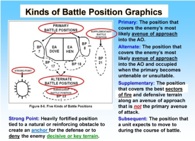Tactics 101: 029 – The Defense
SETTING THE CONDITIONS To assist you in better understanding our future articles on the defense, we will lay-out a foundation of key concepts and definitions you will soon see. Let’s begin with definitions and graphical symbols of the types of battle positions a unit will likely use in a defensive operation.
Key Terms
Below you will find some definitions of some key terms related to the defense. We will utilize them in the near future.
- assailable flank – A flank which is exposed to attack or envelopment. This is particularly critical in the mobile defense. It is this flank which a striking force hopes to find to make its’ attack even more lethal.
- avenue of approach – An air or ground route of an attacking force leading to its objective or to key terrain in its path. During planning, the defender wants to determine these in order to define enemy courses of action which will then lead to constructing his defense.
- canalize – To restrict operations to a narrow zone by use of existing or reinforcing obstacles by fire or bombing. A commander who is able to force his opponent to maneuver in a specific area has certainly improved his ability to mass his effects.
- countermobility – These actions augment natural terrain with obstacle systems according to the commander’s defensive concept. Effectively combining manmade obstacles with existing terrain is a recipe for success.
- counterreconnaissance – Measures taken by a commander to counter enemy reconnaissance and surveillance efforts. In most cases, the winner of the counter-recon fight has set the conditions for future success.
- engagement area – An area where the commander intends to contain and destroy an enemy force with the massed effects of all available weapons and supporting systems. Certainly, the planning, preparation and future execution inside the engagement area are crucial to the defender’s success.
- intervisibility line – A ridge or horizon beyond which equipment or personnel can be hidden
- from observation. Depending on the terrain, the master of the ‘IV’ line will normally be the victor. Those of you who fought conventional fights at the National Training Center know this very well!
- obstacle – Any obstruction designed or employed to disrupt, fix, turn, or block the movement of an opposing force, and to impose additional losses in personnel, time, and equipment on the opposing force. Obstacles can be natural, manmade, or a combination of both.
- piecemeal commitment – The unsynchronized employment of available forces so that their combat power is not employed effectively. This is the ultimate goal of disruption!
- trigger line – A phase line—located on identifiable terrain that crosses the engagement area—used to initiate and mass fires into an engagement area at a predetermined range for all or like weapon systems. The trigger line is key to massing effects. If you initiate fires too early or too late the result is not good!
REVIEW
Hopefully this article has provided you a good general overview on the defense. As discussed the defense is all about preparation, massing effects, and making the enemy react to you and not vice versa. In the future, we will assist you in how you can make the above happen!
NEXT MONTH
We will get more specific next month and discuss how to develop an engagement area. Certainly in defensive planning this is where it all starts. The commander decides where he wants to defeat his enemy and then develops an engagement area to achieve this.
“All right, they’re on our left, they’re on our right, they’re in front of us, they’re behind us…they can’t get away this time.”



